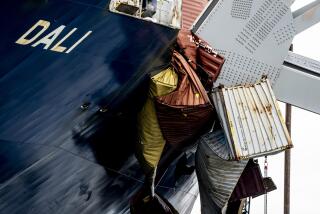Nuclear Reactor Floats Past Portland on Way to Dump
- Share via
PORTLAND, Ore. — A pair of tugboats chugged up the Columbia River on Saturday hauling a 1,000-ton nuclear reactor to a burial site, escorted by a Coast Guard cutter keeping other boats 300 yards away from the radioactive hulk.
The barge carrying the empty reactor vessel floated past Portland during the night, the first time a commercial reactor of that size and level of contamination had passed so near a major American city, according to the Nuclear Regulatory Commission.
“So far it’s been smooth sailing,” said Kregg Arntson, spokesman for Portland General Electric, the utility decommissioning the largest commercial reactor ever taken off-line in the United States.
The dumbbell-shaped vessel is destined for the Hanford Nuclear Reservation in central Washington, where it will be buried 42 feet deep.
After a voyage that began Friday at the dismantled Trojan Nuclear Plant, 40 miles west of Portland, the barge was to stop Saturday night at Pasco, Wash., so the remaining 10 miles of the river could be traveled in daylight.
PGE has shipped Trojan’s contaminated steam generators upriver to Hanford since 1995, and the Navy often ships reactors from submarines and cruisers up the Columbia for burial at the site.
Although it no longer contains its uranium fuel, the Trojan reactor contains 15 times as much radioactivity as those objects, according to state officials.
After being filled with concrete and encased in 6-inch-thick steel, the reactor is considered safe for shipment. Workers handling it wear no more protection than a hard hat.
From Benton, the reactor vessel will be hauled 15 miles on a 320-wheel trailer to the Hanford reservation.
The Trojan plant operated for 16 years, generating enough electricity to supply all of Portland.
It was shut down in 1993, two decades earlier than planned, after a series of problems, including a faulty safety system that drew federal fines, an accidental release of radioactive gases and cracked steam tubes.
Nearly 800 spent but highly radioactive uranium fuel rod assemblies removed from the reactor over the years remain in storage at the Trojan site.
More to Read
Sign up for Essential California
The most important California stories and recommendations in your inbox every morning.
You may occasionally receive promotional content from the Los Angeles Times.













